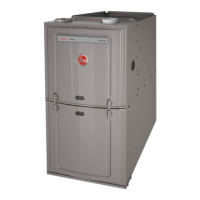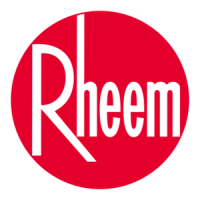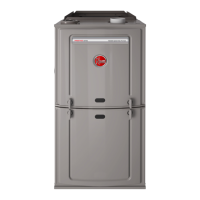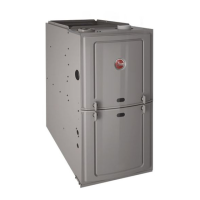
Do you have a question about the Rheem 801S Series and is the answer not in the manual?
| Input BTU/h | 40, 000 - 120, 000 |
|---|---|
| Type | Gas Furnace |
| Heating Capacity | Varies by model |
| Fuel Type | Natural Gas |
| Configuration | Upflow/Horizontal |
| Ignition | Direct Spark Ignition |
| Warranty | 10-Year Limited |
| Model Series | 801S Series |
Information for California residents regarding Proposition 65 warnings and chemical disclosures.
Importance of duct system balance and sealing for efficiency, comfort, and indoor air quality.
Guidelines for choosing an optimal location, site selection, and clearance requirements.
Instructions for connecting ductwork for upflow furnace installations, emphasizing airtightness.
Guidelines for positioning and connecting ductwork for horizontal furnace installations.
Critical requirements for adequate combustion air supply to prevent hazards like CO poisoning.
General information and requirements for venting furnace flue gases to the outdoors.
Instructions for power vent systems and retrofit guidelines for existing vent systems.
Safety information and general requirements for natural gas and propane supply and piping.
Specifications for gas pressures and procedures for setting supply and manifold pressures.
Procedures for converting to LP gas, including pressure and orifice adjustments.
Guidelines for safe electrical connections, junction box relocation, and thermostat wiring.
Overview of optional accessories including EAC, Humidifier, Filters, and Adapters.
Importance of maintaining clean furnace filters for optimal operation.
Guidelines for installing two furnaces side-by-side for increased capacity.
Specific instructions for twinning furnaces using UT Electronic Controls 1194-200 boards.
Procedures for adjusting furnace input and orifice size for high altitude installations.
Detailed sequence for furnace ignition, start-up, and shutdown procedures.
Explanation of display codes for diagnosing furnace faults and dual faults.
Explanation of different lockout types, their triggers, and reset procedures.
How to use dipswitches for configuration and methods for clearing fault codes.
Interpreting flame status LED and understanding operational timing diagrams.
Procedures for checking furnace input, setting rate, and understanding operational timing diagrams.
Methods for checking airflow via temperature rise and selecting blower speeds.
Explanation of limit controls, flame roll-out, and pressure switches for furnace safety.
Guidance on filter maintenance, lubrication, and general system operation.
Recommendations for annual inspections and information on obtaining replacement parts.
Customer advice on operating the furnace efficiently and maintaining the system.
A flowchart to diagnose problems related to the furnace control board.












